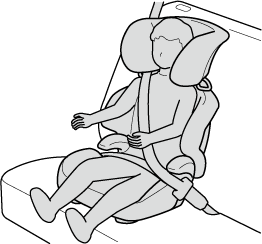Child Restraint
Child-Restraint Precautions
Child-Restraint Precautions
Mazda strongly urges the use of child-restraint systems for children small enough to use them.
Check your local and state or provincial laws for specific requirements regarding the safety of children riding in your vehicle.
Whatever child-restraint system you consider, please pick the appropriate one for the age and size of the child, obey the law and follow the instructions that come with the individual child-restraint system.
A child who has outgrown child-restraint systems should sit in the rear and use seat belts.
The child-restraint system should be installed on the rear seat.
Statistics confirm that the rear seat is the best place for all children up to 12 years of age-the more so with a supplementary restraint system (air bags).
A rear-facing child-restraint system should NEVER be used in the front passenger seat with the air bag system activated. The front passenger's seat is also the least preferred seat for other child-restraint systems.
For some models, we have provided a deactivation switch that will disable front passenger air bag inflation. Do not switch off the front passenger air bag without reading the “Front Passenger Air Bag Deactivation Switch” (Search).
Use the correct size child-restraint system:
For effective protection in vehicle accidents and sudden stops, a child must be properly restrained using a seat belt or child-restraint system depending on age and size. If not, the child could be seriously injured or even killed in an accident.
Follow the manufacturer's instructions and always keep the child-restraint system buckled down:
An unsecured child-restraint system is dangerous. In a sudden stop or a collision it could move causing serious injury or death to the child or other occupants. Make sure any child-restraint system is properly secured in place according to the child-restraint system manufacturer's instructions. When not in use, remove it from the vehicle or fasten it with a seat belt, or latch it down to BOTH ISOFIX anchors, and attach the corresponding tether anchor.
Always secure a child in a proper child-restraint system:
Holding a child in your arms while the vehicle is moving is extremely dangerous. No matter how strong the person may be, he or she cannot hold onto a child in a sudden stop or collision and it could result in serious injury or death to the child or other occupants. Even in a moderate accident, the child may be exposed to air bag forces that could result in serious injury or death to the child, or the child may be slammed into an adult, causing injury to both child and adult.
Extreme Hazard! Never use a rear-facing child-restraint system on the front passenger seat with an air bag that could deploy:
NEVER use a rearward facing child restraint on a seat protected by an ACTIVE AIRBAG in front of it, DEATH or SERIOUS INJURY to the CHILD can occur.
Vehicles with a front passenger air bag have the following warning label. The warning label reminds you not to put a rear-facing child-restraint system on the front passenger seat at any time.
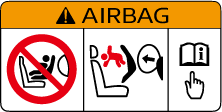
Even in a moderate collision, the child-restraint system can be hit by a deploying air bag and moved violently backward resulting in serious injury or death to the child. When using a rear-facing child-restraint system, always set the front passenger air bag deactivation switch to the OFF position.
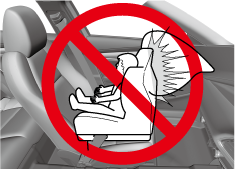
Do not install a front-facing child-restraint system on the front passenger seat unless it is unavoidable:
In a collision, the force of a deploying air bag could cause serious injury or death to the child. If installing a front-facing child-restraint system on the front passenger seat is unavoidable, move the front passenger seat as far back as possible and adjust the seat bottom (height adjustable seat bottom) to the highest position at which the seat belt fastening the child-restraint system is securely tightened.
Make sure that the front passenger air bag deactivation switch is in the OFF position. Refer to Front Passenger Air Bag Deactivation Switch (Search).
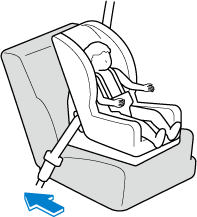
Do not allow a child or anyone to lean over or against the side window of a vehicle with side and curtain air bags:
It is dangerous to allow anyone to lean over or against the side window, the area of the front passenger seat, the front and rear window pillars and the roof edge along both sides from which the side and curtain air bags deploy, even if a child-restraint system is used. The impact of inflation from a side or curtain air bag could cause serious injury or death to an out of position child. Furthermore, leaning over or against the front door could block the side and curtain air bags and eliminate the advantages of supplementary protection. With the front air bag and the additional side air bag that comes out of the front seat, the rear seat is always a better location for children. Take special care not to allow a child to lean over or against the side window, even if the child is seated in a child-restraint system.
Never use one seat belt on more than one person at a time:
Using one seat belt for more than one person at a time is dangerous. A seat belt used in this way cannot spread the impact forces properly and the two passengers could be crushed together and seriously injured or even killed. Never use one belt for more than one person at a time and always operate the vehicle with each occupant properly restrained.
WARNING: child restraint anchorages are designed to withstand only those loads imposed by correctly fitted child restraints. Under no circumstances are they to be used for adult seat belts, harnesses or for attaching other items or equipment to the vehicle.
Always remove the head restraint and install child-restraint system (except when installing a backless booster seat):
Installing a child-restraint system without removing the head restraint is dangerous. The child-restraint system cannot be installed correctly which may result in death or injury to the child in a collision.
A seat belt or child-restraint system can become very hot in a closed vehicle during warm weather. To avoid burning yourself or a child, check them before you or your child touches them.
Your Mazda is equipped with ISOFIX anchors for attachment of ISOFIX child-restraint systems on the rear seats. When using these anchors to secure a child-restraint system, refer to “Using ISOFIX Anchor” (Search).
Child-Restraint System Installation
Categories of Child-Restraint Systems
When purchasing, ask the manufacturer of the child-restraint system which type of child-restraint system is appropriate for your child and vehicle.
(Countries conforming to the UN-R 44 and UN-R 129 regulation)
Child-restraint systems are classified into the following 5 groups according to the UN-R 44 and UN-R 129 regulation.
|
Group |
Age |
Weight |
Size Classification/Fixture (CRF) |
|---|---|---|---|
|
0 |
Up to about 9 months old |
Up to 10 kg (up to 22 lb) |
ISO/L1 |
|
ISO/L2 |
|||
|
ISO/R1 |
|||
|
0+ |
Up to about 2 years old |
Up to 13 kg (up to 29 lb) |
ISO/R1 |
|
ISO/R2 |
|||
|
ISO/R3 |
|||
|
1 |
About 8 months to 4 years old |
9 kg ― 18 kg (20 lb ― 40 lb) |
ISO/R2 |
|
ISO/R3 |
|||
|
ISO/F2 |
|||
|
ISO/F2X |
|||
|
ISO/F3 |
|||
|
2 |
About 3 to 7 years old |
15 kg ― 25 kg (33 lb ― 55 lb) |
― |
|
3 |
About 6 to 12 years old |
22 kg ― 36 kg (48 lb ― 79 lb) |
― |
(Australia)
Child-restraint systems for Australia must conform to Australian Standard AS 1754/91 or later. Refer to your local state authority for the latest specification.
(Other countries)
Please comply with the legal regulations concerning the use of child-restraint systems in your country.
Child-Restraint System Types
In this owner's manual, explanation of child-restraint systems secured with seat belts is provided for the following 3 types of popular child-restraint systems: baby seat, child seat, booster seat.
-
Installation position is determined by the type of child-restraint system. Always read the manufacturer's instructions and this owner's manual carefully.
-
Due to variations in the design of child-restraint systems, vehicle seats and seat belts, all child-restraint systems may not fit all seating positions. Before purchasing a child-restraint system, it should be tested in the specific vehicle seating position (or positions) where it is intended to be used. If a previously purchased child-restraint system does not fit, you may need to purchase a different one that will.
Baby seat
A baby seat provides restraint by bracing the baby's head, neck and back against the seating surface.
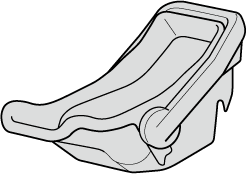
Child seat
A child seat restrains a child's body using the harness.
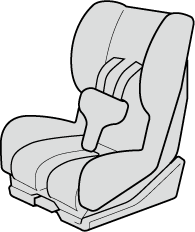
Booster seat
A booster seat is a child restraint accessory designed to improve the fit of the seat belt system around the child's body.

-
Full booster seat
-
Backless booster seat
When using a backless booster seat, always install the vehicle head restraint to the seat where the backless booster seat is installed.
(Australia)
Child-restraint systems for Australia must conform to Australian Standard AS 1754/91 or later.
(Other countries)
Please comply with the legal regulations concerning the use of child-restraint systems in your country.
Baby Seat Installation Position
A baby seat is used in the rear-facing position only.
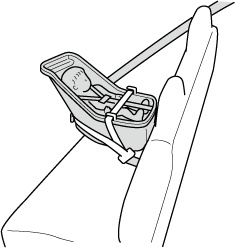
Never use a rear-facing child-restraint system on the front passenger seat protected by an air bag:
NEVER use a rearward facing child restraint on a seat protected by an ACTIVE AIRBAG in front of it, DEATH or SERIOUS INJURY to the CHILD can occur.
The child-restraint system can be hit by the deploying air bag and knocked out of position. A child in the child-restraint system could be seriously injured or killed. If your vehicle is equipped with a front passenger air bag deactivation switch, always set the switch to the OFF position if installing a rear-facing child-restraint system on the front passenger seat is unavoidable.
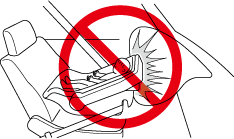
Child Seat Installation Position
A child seat is used in front-facing and rear-facing positions depending on the age and size of the child. When installing, follow the manufacturer's instructions in accordance with the appropriate age and size of the child as well as the directions for installing the child-restraint system.
Rear-facing type
Never use a rear-facing child-restraint system on the front passenger seat protected by an air bag:
NEVER use a rearward facing child restraint on a seat protected by an ACTIVE AIRBAG in front of it, DEATH or SERIOUS INJURY to the CHILD can occur.
The child-restraint system can be hit by the deploying air bag and knocked out of position. A child in the child-restraint system could be seriously injured or killed. If your vehicle is equipped with a front passenger air bag deactivation switch, always set the switch to the OFF position if installing a rear-facing child-restraint system on the front passenger seat is unavoidable.
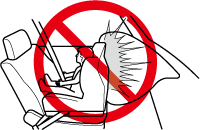
Front-facing type
Do not install a front-facing child-restraint system on the front passenger seat unless it is unavoidable:
In a collision, the force of a deploying air bag could cause serious injury or death to the child. If installing a front-facing child-restraint system on the front passenger seat is unavoidable, move the front passenger seat as far back as possible and adjust the seat bottom (height adjustable seat bottom) to the highest position at which the seat belt fastening the child-restraint system is securely tightened.
Make sure that the front passenger air bag deactivation switch is in the OFF position. Refer to Front Passenger Air Bag Deactivation Switch (Search).

Booster Seat Installation Position
Child-Restraint System Suitability for Various Seat Positions Table
Child-Restraint System Suitability for Various Seat Positions Table
Provided information in the table shows your child-restraint system suitability for various seating position. For installation suitability of other manufacturer child-restraint system, carefully consult the manufacturer's instructions which accompany the child-restraint system.
When installing a child-restraint system, the following points must be observed:
-
Always remove the head restraint before installing a child-restraint system. However, when installing a backless booster seat, always install the vehicle head restraint to the seat where the backless booster seat is installed. In addition, always use a tether strap and attach it securely. Refer to Head Restraints (Search).
-
When installing a child-restraint system to the front passenger seat, adjust the seat slide position as far back as possible. Adjust the seat bottom to the highest position so that the seat belt can securely fasten the child-restraint system.
Refer to Adjusting the Front Passenger's Seat (Search).
-
When it is difficult to install a child-restraint system to the front passenger seat, or the seat belt cannot be secured to the child-restraint system, perform the following operations to adjust the seat holding the child-restraint system so that the seat belt can be secured completely to it.
-
Move the seat forward or back.
-
Move the seatback forward or back.
-
Move the seat upward or downward. (Vehicles with height adjustment function)
-
-
When installing a child-restraint system to the rear seat, adjust the front seat position so that the front seat does not contact the child-restraint system.
Refer to Adjusting the Driver's Seat (Search).
Refer to Adjusting the Front Passenger's Seat (Search).
-
When installing a child-restraint system came equipped with a tether, remove the head restraint.
Refer to Head Restraints (Search).
-
An i-Size child-restraint system refers to a child-restraint system which has acquired i-Size category certification for the UN-R 129 regulation.
When installing a child-restraint system to the rear seat, refer to the child-restraint system manufacturer's instructions and the Using ISOFIX Anchor (Search).
|
Seating position |
Passenger |
Rear (Left) |
Rear (Centre) |
Rear (Right) |
|
|---|---|---|---|---|---|
|
Airbag activated |
Airbag de-activated |
||||
|
Seating position suitable for universal belted (Yes/No) |
Yes (UF) |
Yes (U) |
Yes (U) |
Yes (U) |
Yes (U) |
|
i-Size seating position (Yes/No) |
No |
No |
Yes (i-U) |
No |
Yes (i-U) |
|
Largest suitable rearward facing fixture (R1) |
No |
No |
Yes (IL) |
No |
Yes (IL) |
|
Largest suitable rearward facing fixture (R2) |
No |
No |
Yes (IL) |
No |
Yes (IL) |
|
Largest suitable rearward facing fixture (R2X) |
No |
No |
Yes (IL) |
No |
Yes (IL) |
|
Largest suitable rearward facing fixture (R3) |
No |
No |
Yes (IL) |
No |
Yes (IL) |
|
Largest suitable forward facing fixture (F2) |
No |
No |
Yes (IUF) |
No |
Yes (IUF) |
|
Largest suitable forward facing fixture (F2X) |
No |
No |
Yes (IUF) |
No |
Yes (IUF) |
|
Largest suitable forward facing fixture (F3) |
No |
No |
Yes (IUF) |
No |
Yes (IUF) |
|
Largest suitable lateral facing fixture (L1) |
No |
No |
No |
No |
No |
|
Largest suitable lateral facing fixture (L2) |
No |
No |
No |
No |
No |
|
Largest suitable booster fixture (B2) |
No |
No |
Yes (IUF) |
No |
Yes (IUF) |
|
Largest suitable booster fixture (B3) |
No |
No |
Yes (IUF) |
No |
Yes (IUF) |
|
Non i-size compatible with a support leg (Yes/No) |
Yes*1 |
Yes |
Yes |
No |
Yes |
|
Lower ISOFIX anchorages but without Top Tether (Yes/No) |
No |
No |
No |
No |
No |
U = Suitable for “universal” category restraints approved for use in this mass group.
UF = Suitable for forward-facing “universal” category restraints approved for use in this mass group.
IUF = Suitable for ISOFIX forward child restraints systems of universal category approved for use in the mass group.
L = Suitable for particular child restraints given on attached list. These restraints may be of the “specific vehicle”, “restricted” or “semi-universal” categories.
IL = Suitable for particular ISOFIX child restraint systems (CRS) given in the attached list. These ISOFIX CRS are those of the “specific vehicle”, “restricted” or “semi-universal” categories.
i-U = Suitable for i-Size “universal” Child Restraint Systems forward and rearward facing.
i-UF = Suitable for forward-facing i-Size “universal” Child Restraint Systems only.
Yes = Child-restraint system can be secured on the seat.
No = Child-restraint system cannot be secured on the seat, or there is no fixture.
X = Child-restraint system cannot be installed.
-
Child restraint system can only be installed in the forward-facing position.
A Mazda genuine child-restraint system can be installed. Regarding child-restraint systems which can be installed, refer to the accessories catalog.
Installing Child-Restraint Systems
Anchor Bracket
Anchor brackets for securing child-restraint systems are equipped in the vehicle. Locate each anchor position using the illustration.
To install a child-restraint system, remove the head restraint. Always follow the instruction manual accompanying the child-restraint system.
Anchor bracket location
Use the indicated anchor bracket locations when installing a child-restraint system equipped with a tether.
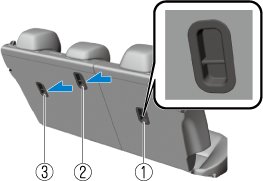
-
For right
-
For centre
-
For left
WARNING: child restraint anchorages are designed to withstand only those loads imposed by correctly fitted child restraints. Under no circumstances are they to be used for adult seat belts, harnesses or for attaching other items or equipment to the vehicle.
Always attach the tether strap to the correct tether anchor position:
Attaching the tether strap to the incorrect tether anchor position is dangerous. In a collision, the tether strap could come off and loosen the child-restraint system. If the child-restraint system moves it could result in death or injury to the child.
Always remove the head restraint and install child-restraint system:
Installing a child-restraint system without removing the head restraint is dangerous. The child-restraint system cannot be installed correctly which may result in death or injury to the child in a collision.
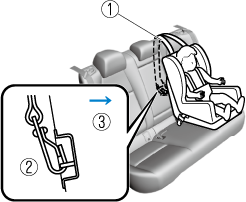
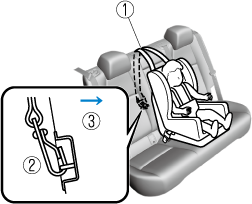
-
Tether strap
-
Anchor bracket
-
Forward
Always install the head restraint and adjust it to the appropriate position after removing the child-restraint system:
Driving with the head restraint removed is dangerous as impact to the occupant's head cannot be prevented during emergency braking or in a collision, which could result in a serious accident, injury or death.
Refer to Head Restraints (Search).
Using Automatic Locking Mode
Follow these instructions when using the automatic locking mode for a child-restraint system.
-
Make sure the seatback is securely latched by pushing it back until it is fully locked.
-
Remove the head restraint. However, when installing a backless booster seat, always install the vehicle head restraint to the seat where the backless booster seat is installed.
Refer to Head Restraints (Search).
-
Secure the child-restraint system with the lap portion of the lap/shoulder belt. See the manufacturer's instructions on the child-restraint system for belt routing instructions.
-
To get the retractor into the automatic locking mode, pull the shoulder belt portion of the seat belt until the entire length of the belt is out of the retractor.
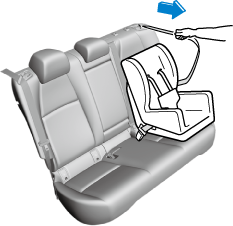
-
Push the child-restraint system firmly into the vehicle seat. Be sure the belt retracts as snugly as possible. A clicking noise from the retractor will be heard during retraction if the system is in the automatic locking mode. If the belt does not lock the seat down tight, repeat this step.
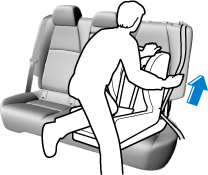
-
Inspect this function before each use of the child-restraint system. You should not be able to pull the shoulder belt out of the retractor while the system is in the automatic locking mode. When you remove the child-restraint system, be sure the belt fully retracts to return the system to emergency locking mode before occupants use the seat belts.
-
-
If your child-restraint system requires the use of a tether strap, refer to the manufacturer's instructions to hook and tighten the tether strap.
WARNING: child restraint anchorages are designed to withstand only those loads imposed by correctly fitted child restraints. Under no circumstances are they to be used for adult seat belts, harnesses or for attaching other items or equipment to the vehicle.
Always remove the head restraint and install child-restraint system (except when installing a backless booster seat):
Installing a child-restraint system without removing the head restraint is dangerous. The child-restraint system cannot be installed correctly which may result in death or injury to the child in a collision.

-
Tether strap
-
Anchor bracket
-
Forward
Always attach the tether strap to the correct tether anchor position:
Attaching the tether strap to the incorrect tether anchor position is dangerous. In a collision, the tether strap could come off and loosen the child-restraint system. If the child-restraint system moves it could result in death or injury to the child.
Always install the head restraint and adjust it to the appropriate position after removing the child-restraint system:
Driving with the head restraint removed is dangerous as impact to the occupant's head cannot be prevented during emergency braking or in a collision, which could result in a serious accident, injury or death.
Refer to Head Restraints (Search).
Centre-Rear Seat Child-Restraint System Installation
-
Make sure the seatback is securely latched by pushing it back until it is fully locked.
-
Remove the head restraint. However, when installing a backless booster seat, always install the vehicle head restraint to the seat where the backless booster seat is installed.
Refer to Head Restraints (Search).
-
Secure the child-restraint system with the seat belt, according to the manufacturer's instructions.
-
Secure the tether strap according to the child-restraint system manufacturer's instruction.
WARNING: child restraint anchorages are designed to withstand only those loads imposed by correctly fitted child restraints. Under no circumstances are they to be used for adult seat belts, harnesses or for attaching other items or equipment to the vehicle.
Always remove the head restraint and install child-restraint system (except when installing a backless booster seat):
Installing a child-restraint system without removing the head restraint is dangerous. The child-restraint system cannot be installed correctly which may result in death or injury to the child in a collision.

-
Tether strap
-
Anchor bracket
-
Forward
Always attach the tether strap to the correct tether anchor position:
Attaching the tether strap to the incorrect tether anchor position is dangerous. In a collision, the tether strap could come off and loosen the child-restraint system. If the child-restraint system moves it could result in death or injury to the child.
Always install the head restraint and adjust it to the appropriate position after removing the child-restraint system:
Driving with the head restraint removed is dangerous as impact to the occupant's head cannot be prevented during emergency braking or in a collision, which could result in a serious accident, injury or death.
Refer to Head Restraints (Search).
Using ISOFIX Anchor
Follow the manufacturer's instructions for the use of the child-restraint system:
An unsecured child-restraint system is dangerous. In a sudden stop or a collision it could move causing serious injury or death to the child or other occupants. Make sure any child-restraint system is properly secured in place according to the manufacturer's instructions.
Make sure the child-restraint system is properly secured:
A child-restraint system that is not secured is dangerous. In a sudden stop or collision, it can become a projectile and hit someone, causing serious injury. When not in use, remove it from the vehicle, put it in the luggage compartment or at least make sure it is securely fastened to the ISOFIX anchors.
Make sure there are no seat belts or foreign objects near or around the ISOFIX anchor-secured child-restraint system:
Not following the child-restraint system manufacturer's instructions when installing the child-restraint system is dangerous. If seat belts or a foreign object prevent the child-restraint system from being securely attached to the ISOFIX anchors and the child-restraint system is installed improperly, the child-restraint system could move in a sudden stop or collision causing serious injury or death to the child or other occupants. When installing the child-restraint system, make sure there are no seat belts or foreign objects near or around the ISOFIX anchors. Always follow the child-restraint system manufacturer's instructions.
-
First, adjust the front seat to allow clearance between the child-restraint system and the front seat.
Refer to Adjusting the Driver's Seat (Search).
Refer to Adjusting the Front Passenger's Seat (Search).
-
Make sure the seatback is securely latched by pushing it back until it is fully locked.
-
Remove the cover of the child-restraint system's ISOFIX anchors to verify the locations of the ISOFIX anchors.
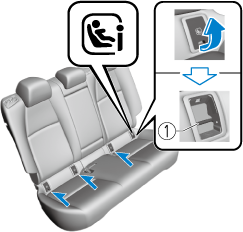
-
ISOFIX anchor
-
The ISOFIX anchors marking on the cover indicates the position of the ISOFIX anchors for the attachment of a child-restraint system.
-
Store the removed cover so that it does not get lost.
-
-
Remove the head restraint. However, when installing a backless booster seat, always install the vehicle head restraint to the seat where the backless booster seat is installed.
Refer to Head Restraints (Search).
-
Secure the child-restraint system using the ISOFIX anchor, following the child-restraint system manufacturer's instruction.
-
If your child-restraint system came equipped with a tether, that probably means it is very important to properly secure the tether for child safety. Please carefully follow the child-restraint system manufacturer's instructions when installing tethers (Search).
WARNING: child restraint anchorages are designed to withstand only those loads imposed by correctly fitted child restraints. Under no circumstances are they to be used for adult seat belts, harnesses or for attaching other items or equipment to the vehicle.
Always attach the tether strap to the correct tether anchor position:
Attaching the tether strap to the incorrect tether anchor position is dangerous. In a collision, the tether strap could come off and loosen the child-restraint system. If the child-restraint system moves it could result in death or injury to the child.
Always remove the head restraint and set the tether strap (except when installing a backless booster seat):
Routing the tether strap on top of the head restraint is dangerous. In a collision the tether strap could slide off the head restraint and loosen the child-restraint system. The child-restraint system could move which may result in death or injury to the child.
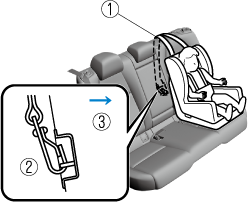
-
Tether strap
-
Anchor bracket
-
Forward
Always install the head restraint and adjust it to the appropriate position after removing the child-restraint system:
Driving with the head restraint removed is dangerous as impact to the occupant's head cannot be prevented during emergency braking or in a collision, which could result in a serious accident, injury or death.
Refer to Head Restraints (Search).






























































